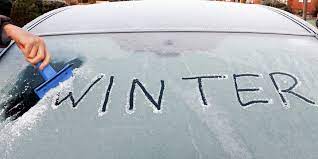As we move into December the weather is still remarkably mild for the time of year, but don’t let this fool your drivers into a false sense of security. The onset of winter brings with it a huge range of risks on the road, with the possibility of adverse conditions that can change multiple times within one journey. It is important to be as well prepared as possible.
Preparing for the colder weather
It is important to regularly check and maintain vehicles to ensure they are roadworthy. These checks are even more significant before the onset of adverse conditions. Ensure the following checks are carried out before winter arrives:
- All vehicle lights should be tested to ensure they work, and cleaned if necessary
- The battery should be working and charged
- The brakes should be working well
- The windscreen, wiper blades and other windows should be checked to ensure they are clean and free from damage, and the washer bottle should be filled with screen wash at the correct concentration to avoid freezing
- All tyres should be checked for their condition, pressure and tread depth. Although the legal limit for tread depth is 1.6mm, we recommend replacing tyres when they reach 3mm to ensure a consistent good grip of the road surface.
Preparing for your journey
Before and during travel, it is crucial that your drivers and your vehicles are prepared for the adverse conditions that winter brings. Before setting out on a journey:
- Listen to local and national weather reports and accept that plans may have to be revised as conditions can change quickly. Drivers should continue to listen to these reports during their journey and take appropriate action as conditions dictate.
- Turn heating on to help keep the windscreen clear and remove any snow or ice from all windows and mirrors before starting out.
- Ensure that there is ample fuel in the vehicle.
If the conditions are very bad, the safest option is to not take the journey: avoid travelling unless the journey is absolutely essential. If you must travel, ensure you let someone know where you are going and when you intend to arrive. You should take a fully charged mobile phone with you, as well as an emergency kit consisting of warm clothes, gloves and some food as a minimum, in case you become stranded.
Travelling in adverse conditions
Some of the conditions brought about by winter can make the road a very risky and dangerous place. Snow and ice can cause braking distances to be up to 10 times higher than in normal conditions. When driving in ice or snow, you should keep a much larger gap than usual between you and the vehicle in front. To slow down in these conditions, lift the accelerator pedal early to allow the speed to drop sufficiently to select a lower gear. If you need to use the brakes, apply very gentle pressure. Never brake or accelerate harshly in poor conditions, and avoid sharp steering.
Winter causes an increase in fog, one of the most dangerous weather conditions to travel in. If you have to drive in fog, make sure you allow lots of extra time for your journey so you don’t have to rush, and ensure that all of your lights are working before you set off. You should travel at a consistently low speed, and switch on your headlights and fog lights if visibility is reduced.
Never “hang on” to the rear lights of the car in front of you, as it is likely you will be too close to them to brake safely if you need to stop. Open the window to listen out for traffic if you need to, especially at junctions and crossroads.
Do not speed up immediately if visibility improves slightly. In patchy fog it is possible your visibility could be dramatically reduced again only moments later.











